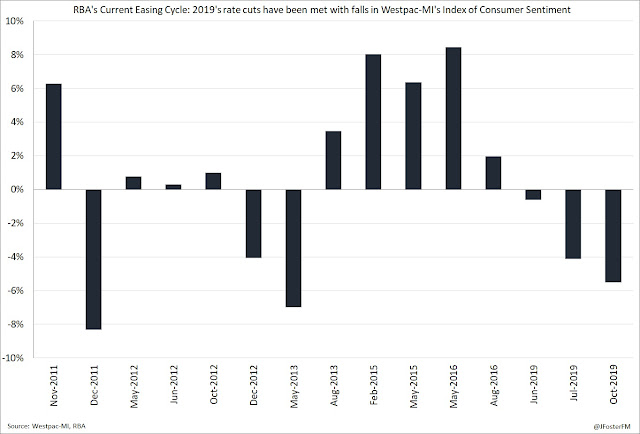Building Approvals — September | By the numbers
- Total dwelling approvals (including both the private and public sectors) increased by 7.6% in September to 14,004 against expectations for a flat outcome. August's initially reported decline of -1.1% was revised to -0.6%.
- The year-on-year decline in dwelling approvals eased from -21.1% (revised from -21.5%) to -19.0%.
- Unit approvals surged by 16.1% in the month to 5,500 to be down by -27.8% through the year (prior rev: +1.8%m/m, -28.5%Y/Y).
- House approvals lifted by 2.7% in September to 8,504 for an annual fall of -12.0% (prior rev: -2.0%m/m, -16.1%Y/Y).
Building Approvals — September | The details
In the 3 months to September, the aggregate of dwelling approvals was 40,121 — its lowest quarterly total since Q2 2012 — representing a decline of 7.4% on Q2's total of 43,340. The 4-quarter profile for dwelling approvals is -11.1% in Q4 (2018), +1.8% in Q1, -7.8% in Q2 and -7.4% in Q3. For the September quarter, the weakness was predominantly in units (-14.9% to 14,892), though house approvals also declined (-2.4% to 25,230).
In the 3 months to September, the aggregate of dwelling approvals was 40,121 — its lowest quarterly total since Q2 2012 — representing a decline of 7.4% on Q2's total of 43,340. The 4-quarter profile for dwelling approvals is -11.1% in Q4 (2018), +1.8% in Q1, -7.8% in Q2 and -7.4% in Q3. For the September quarter, the weakness was predominantly in units (-14.9% to 14,892), though house approvals also declined (-2.4% to 25,230).
As a result of the ongoing declines in approvals, the outlook for residential construction activity is very weak and is therefore likely to remain a drag on output growth well into next year.
Looking across the states, approvals were volatile in September; New South Wales -2.5% (-27.2%Y/Y), Victoria +3.3% (-27.6%Y/Y), Queensland +19.6% (-12.0%Y/Y), South Australia +16.0% (-9.0%Y/Y), Western Australia -24.5% (-19.3%Y/Y) and Tasmania +3.4% (+6.6%Y/Y).
Over Q3, the weakness continued to be driven by New South Wales (-14.8%) and Victoria (-9.1%). There were more moderate declines in Queensland (-2.2%) and Western Australia (-3.5%), while South Australia (+10.2%) and Tasmania (+11.0%) posted increases.
The value of alteration work approved to existing residential properties posted a 2.8% rise in September to $708.8m to be up by 3.0% on a year earlier. Non-residential work approved slumped by 36.6% in the month to $3.95bn and partially reversed a 58.8% rise in August, but it remains in a strong uptrend at +14.0%Y/Y.
Building Approvals — September | Insights
September's 7.6% increase in dwelling approvals ended a run of 3 consecutive monthly declines, though it was driven mostly by the volatile unit segment. Nevertheless, the 2.7% increase in house approvals was its strongest monthly gain since June 2018. While the downtrend for units remains in place, house approvals may be starting to level out. Overall, the takeaway is that further weakness in residential construction activity appears likely to continue until well into 2020.

































